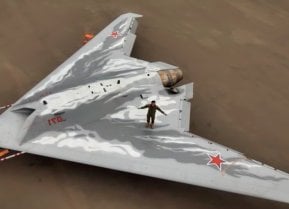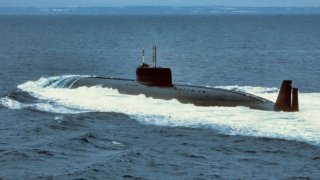Why The Navy Never Built Deep Diving and Fast Titanium Submarines Like Russia
The answer to why the U.S. Navy didn't build titanium submarines could be that it was meant to help maintain the secrecy and security of the SR-71.
Why no titanium submarines like the U.S. Navy? Following the end of the Cold War, titanium became the "go-to" material of choice for many high-end consumer products – notably bicycles, golf clubs, tennis rackets, and even skis. The strength-to-weight ratio made titanium a great material choice in the sporting goods market where weight reduction was beneficial. Not only could the equipment with a low density improve the performance of athletes, but titanium could allow it to last longer.
Moreover, titanium had a high corrosion resistance, low level of elasticity, and tolerance to scratch and damage.
Given such properties, there is the question of why the United States Navy didn't follow the lead of the Soviet Union and attempt to employ the metal for its nuclear-powered submarines. The answer is a bit complex and really came down to the fact that the U.S. was late to understanding its potential.
Titanium: Readily Available
Despite the fact that titanium is one of the most abundant metals found in the earth's crust, throughout the Cold War period it was considered a strategic material by the U.S. government. A large stockpile of titanium sponge – a porous form of the pure metal – was even maintained by the Defense National Stockpile Center, until the stockpile was dispersed in the 2000s.
In the 1950s and 1960s, the Soviet Union pioneered the use of titanium in military applications, notably in its submarine program.
As Dr. Brent Eastwood noted for The National Interest, "Titanium alloy is usually stronger than steel but weighs half as less. It is more expensive, up to three to five times more than steel. Titanium is also less corrosive in salt water. It can handle more pressure during deeper dives – all the way down to 2,200 feet. Fashioning titanium to make a hull is no easy feat. Welding is difficult and the slightest mistake during the welding phase could make the titanium brittle and less strong. Welders did their jobs in expensive facilities that had argon gas, making for dangerous work."
The U.S. Navy considered creating its own supply chain for titanium but determined the effort and cost would not be worth it. That might seem odd given that titanium is used today as a pigment in house paint. But back in the early 1960s, it was practically unobtainium.
We need to remember that the United States Air Force's SR-71 "Blackbird" was the first U.S. aircraft to utilize titanium alloy in the airframe. Along with its low weight, titanium was the only material that could provide the durability of stainless steel at excessive temperatures.
However, the United States didn't have any major sources of the metal, nor did any U.S. allies. That is somewhat ironic as it turns out that titanium is the ninth most abundant element on Earth. It is almost always present in igneous rocks and the sediments derived from them. It occurs in the minerals ilmenite, rutile, and sphene and is present in titanates and many iron ores.
The issue was complicated by the fact that while it was fairly common, the Soviet Union pioneered its use in military and submarine applications. Seeing its potential, the U.S. government sought to obtain as much of the lightweight material as possible, declaring it a strategic metal and creating that stockpile.
In fact, much of the titanium used in the SR-71 ended up being sourced from the same nation the aircraft was used to spy on – namely the Soviet Union. The raw materials were bought from third-world countries and fake companies set up by the CIA.
"The airplane is 92% titanium inside and out. Back when they were building the airplane the United States didn’t have the ore supplies – an ore called rutile ore. It's a very sandy soil and it’s only found in very few parts of the world. The major supplier of the ore was the USSR. Working through Third World countries and bogus operations, they were able to get the rutile ore shipped to the United States to build the SR-71," former SR-71 pilot Colonel Rich Graham told the BBC in 2013.
It wasn't just obtaining the titanium that was an issue for the designers of the high-speed aircraft. There was also a very valid concern that the use of cadmium-plated steel tools could weaken the body of the aircraft if mishandled, which meant that even new tools had to be designed and fabricated.
Those, too, were made from titanium.
Is There More to the Submarine Story?
As Eastwood also noted, "The Russian boats were fast because of the titanium but they were not as quiet as advertised. The Americans felt that titanium was not worth the trouble and cost."
It should be added that all welding of titanium must be done in an inert atmosphere of argon or helium to shield it from contamination with atmospheric gases, including oxygen, nitrogen, and hydrogen. Contamination causes a variety of conditions, such as embrittlement, which reduces the integrity of the assembly welds and leads to joint failure.
The Soviets may have been willing to risk the safety of the crews on board its submarines – as noted by its numerous submarine accidents – but the United States Navy certainly wasn't. Titanium thus didn't become the metal of choice then and still isn't employed for U.S. submarines.
However, during the Cold War, we can speculate that another issue was that the CIA was already struggling to obtain the metal for the SR-71. Simply put, it likely would have been difficult – if not impossible – for the agency to purchase enough titanium for the U.S. Navy without alerting Moscow in the process.
The answer to why the U.S. Navy didn't build titanium submarines could be that it was meant to help maintain the secrecy and security of the SR-71.
Author Experience and Expertise
Peter Suciu is a Michigan-based writer. He has contributed to more than four dozen magazines, newspapers, and websites with over 3,200 published pieces over a twenty-year career in journalism. He regularly writes about military hardware, firearms history, cybersecurity, politics, and international affairs. Peter is also a Contributing Writer for Forbes and Clearance Jobs. You can follow him on Twitter: @PeterSuciu.


